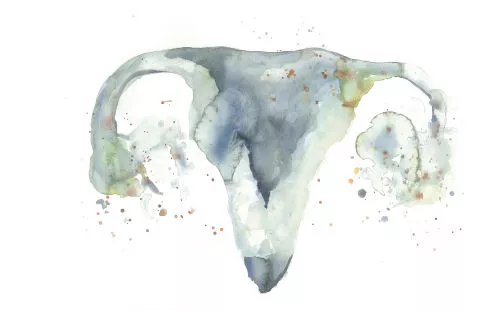Every woman that has gone through or is currently involved in assisted reproductive therapy will know that the thickness of her uterine lining is almost as important as the number of eggs that are developing. To use the common metaphor of growing a garden; the soil must be sufficiently nourished for the seed to have success once it is planted. During an IVF cycle or IUI cycle, a woman will be given different medications that will either directly or indirectly increase the estrogen delivered to the uterus and more specifically, the endometrial lining. For those that are trying to conceive without assisted techniques they will not know the thickness of their endometrial lining but this may be a limiting factor in their chances of conceiving.
The optimal thickness for the endometrial lining is between 10 and 15 mm with it reaching its maximum thickness at the time of implantation at around day 21 of a woman’s menstrual cycle. The growth of the endometrial lining is dependent upon the quality of blood flow to the uterus as well as the effect of estrogen in encouraging the lining to develop. Therefore the treatment approach when working with women that are prone to having a thin uterine lining is to increase blood flow to the reproductive organs, increase receptivity of the uterus to estrogen and balance reproductive hormones.
During an IVF cycle or IUI there are two main approaches used to increase the uterine lining and both have to do with increasing estrogen. One approach is to administer estrogen directly, either orally or vaginally. The common prescription we see most women on is Estrace (estradiol, E2) which is a micronized 17β-estradiol. The other method that may be used is to give human menopausal gonadotropin (hMG) such as Repronex or Bravelle. HMG works by stimulating the pituitary to release follicle stimulating hormone and luteinizing hormone which also triggers the release of estrogen by the reproductive organs. This is more of an indirect method of stimulating estrogen to act on the uterine lining. Both of these methods are effective and may be used in combination for some women.
The approach with Chinese medicine and acupuncture works at both improving estrogen response and increasing blood flow to the uterus. Since acupuncture does not involve the injection of any substance into the body, its focus is more on regulation and increasing blood flow. Some favourable studies have been published that show a positive effect of administering acupuncture with low frequency electric stimulation to points in the lower abdomen and on the lower limbs for increasing blood flow to the uterus and ovaries. Acupuncture has also shown to be quite effective for relieving stress and relaxing the sympathetic nervous system. This is beneficial for improving the body’s response to hormonal signals and increased blood flow throughout the body. Chinese medicine on the other hand does involve the ingestion of active ingredients from natural substances and these can have estrogenic effects as well as blood invigorating effects to improve circulation. For example, Angelica (Dang Gui) has exhibited estradiol increasing effects in controlled studies and has been used for hundreds of years as a primary herb in many Chinese medicine formulas for the treatment of women’s health and regulation of menstrual cycles. Flattened milk vetch seed (Sha Yuan Zi) has been shown in clinical trials to have the effect of increasing the blood flow to the uterus and increase its weight. The combination of these two herbs may be utilized in treating women with a thin uterine lining. However, Chinese medicine is prescribed based on an individualized diagnosis and should only be administered by someone who is a licensed practitioner qualified to prescribe Chinese medicine.
So what can women do on their own to increase blood flow to the reproductive organs, increase receptivity of the uterus to estrogen and balance reproductive hormones?
The number one thing you can do for improving a thin uterine lining is get enough rest. Most of the women we see coming to the clinic for fertility and reproductive support all check off that they do not get adequate sleep. You need a minimum of 7 hours of restful, uninterrupted sleep to recharge your body and allow for optimal repair and growth to take place. Try to get to sleep and wake up at the same time every day, even on weekends. Your sleep and wake hormones influence your reproductive hormones so keep them balanced and your uterus will get the right message. If there is a dog or cat that is waking you up during the night, you will need to train them to sleep through the night, put them in another room or let your partner deal with them. Your sleep is too important to lose.
Exercise is important for increasing blood flow. Strive for 30 minutes per day of exercise that incorporates movement of the legs and hips such as yoga, walking, running, cycling, swimming, elliptical, or aerobics. The goal of exercise is to invigorate circulation and not to exhaust your body. If you are not used to doing exercise then take it slow, build up to a comfortable routine that elicits a light sweat and improved circulation to your hands and feet.
Another helpful self-treatment is femoral artery massage. This is done daily in the first half of a woman’s cycle to increase the blood flow to the uterus and reproductive organs. For full instructions on this visit the self-treatment section on the Yinstill Reproductive Wellness website: https://yinstill.com/self-treatment-home
Stress can also play a major role limiting blood circulation and can interfere with the correct communication between the uterus and hormones. It is recommended that women take time each day to relax, breathe and calm their mind. This can be done with yin style yoga,meditation, guided relaxation and prayer. Choose one or more of these to do on a daily basis and relieve the effects of stress.
Diet can also play a major role in increasing receptivity of the uterus to estrogen, balancing hormones and increasing blood flow. It is recommended to focus on a primarily whole food high fiber, paleolithic/primal style diet that is low glycemic. Eat at regular intervals throughout the day and stick to a routine so your body knows when it will be getting food each day. This helps to balance your insulin and cortisol hormones which have an indirect effect to balance reproductive hormones. Include cruciferous vegetables of the Brassica genus. Some of these vegetables include broccoli, Brussels sprouts, cabbage, collards, cauliflower, kale, kohlrabi, mustard greens, rapeseed, and root vegetables such as turnips and rutabagas. These foods help the liver detoxify and restore hormonal balance. Eliminate glucose-fructose, or high fructose corn syrup, these are sugars that are not well metabolized by the body and can cause insulin resistance which can negatively affect the communication of reproductive hormones. Reduce or eliminate coffee and other forms of stimulants. Avoid animal meats, cheeses, milks and other food items that have been raised with the use of hormones. Choose organic, free range, grass fed animals whenever possible.
Co-enzyme Q10 is commonly recommended for women and men while they are trying to conceive and to improve the micro-circulation of the heart. CoQ10 is a powerful anti-oxidant and therefore assists in reducing oxidative stress to tissues. Since the uterus is reliant on the nourishment of blood and undergoes growth and sloughing at regular intervals, the use of CoQ10 can benefit the integrity of the tissue and possibly improve blood circulation.
Diet and supplementation as suggested above will likely show gradual results so it is important to start early and stay focused on your goal. It is also something that will likely improve your chances of success with assisted reproductive techniques. So be patient, stay calm, choose healthy food options that support endometrial growth and hormonal regulation, and get plenty of rest.
If you would like to discuss how acupuncture and Chinese medicine might benefit you in improving the thickness of your uterine lining please give me a call to set up a free 15 minute consultation or to book an initial appointment at 604.873.9355 (WELL).


